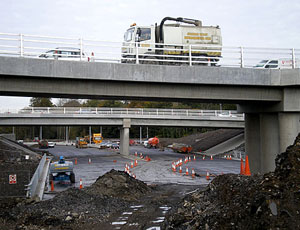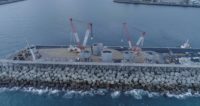...to the site and starts dealing with the technical scheme, looking for [design] alternatives and improvements,” he adds.
But the concern of embedding a Spanish team with Atkins turned out to be unnecessary. Atkins’s approach on both schemes “was completely different,” says Martin de Santa Olalla. “Here, they have been much more open to our ideas, and they have proposed good alternatives. These big projects are a team thing,” he says.

Says Atkins’s O’Malley, “We were anxious from the start to have a good relationship. It was very important getting to understand how the Spanish operate.” Spanish contractors are “very strong technically in terms of design...they like to get heavily involved,” adds Neuling, who adds they have “a keen eye” on cost.
The largest alternative design the M50 team developed to enhance construction was at the complicated interchange with the N3 highway, running out from Dublin.
NRA’s original scheme called for a new section of highway to be excavated under an active railroad and waterway. The contractor’s alternative replaced underground work with an elevated section, and it eliminated a planned new road loop to transfer traffic between highways.
“The most important reason...was that dealing with Irish Railways would be one of the biggest risks in terms of program,” says Martin de Santa Olalla. “It’s very difficult because they ask for so many things. It would have been suicide for us.”
Nine months of time was needed for additional planning approvals, with the possibility officials would reject the plan. “There was quite a high risk from a program point of view,” says Neuling. “It’s more common [than in Ireland] for a Spanish contractor to change a design...but the statutory procedures and the time it would take is not something they would be used to,” he adds.
On the two DBFOs, the Spanish influence extended into the construction phase. On the M50, Spaniards hold senior engineer and manager positions down to site-surveyor level. Of the 100 or so contractor staff, about a third are from Spain.
On the N6, the contractor imported its own paving equipment and crews to overcome limited competition among Irish firms, says Martin de Santa Olalla. “There is almost a monopoly of subcontractors, especially in terms of pavement,” he says. “That left us in a weak position.”
But the N6 is a greenfield project on which road surfacing came well into the schedule. Upgrading the M50 allows no time and little space to accommodate imported plant. So the contractor hired Limerick-based Roadbridge Ltd. to do the paving.
Work on the 33-month M50 contract is on budget and on schedule for completion late this year, says Neuling. After that, the construction team will disband, while M50 Concession Ltd. continues its operations and maintenance work for what’s left of the 35-year contract.
The contractor will earn monthly fees linked to the highway’s availability to cover the construction and operational costs. NRA will partially fund those payments with tolls it will receive from M50 users.
NRA phased out the original toll plazas in August 2008, replacing them with a barrier-free alternative. The joint venture BetEire Flow won the $160-million design, build and operate contract for the electronic system some three years ago.
BetEire may be controlled by SANEF, one of the largest operators of French toll roads. But Spanish influence extends even into this contract. Since SANEF’s privatization a few years ago, that other large Spanish operator, Abertis Infraestructuras S.A., became its owner.



Post a comment to this article
Report Abusive Comment